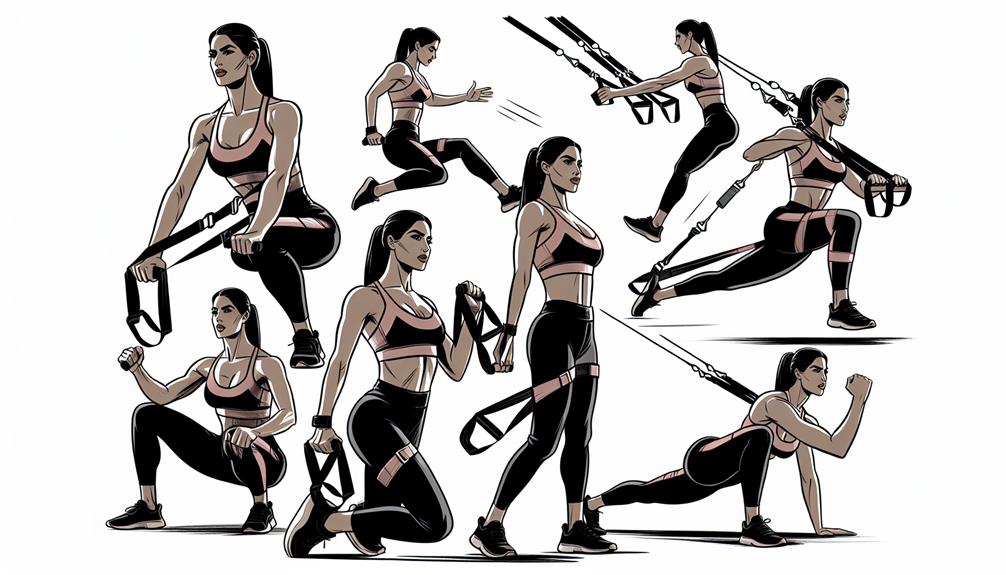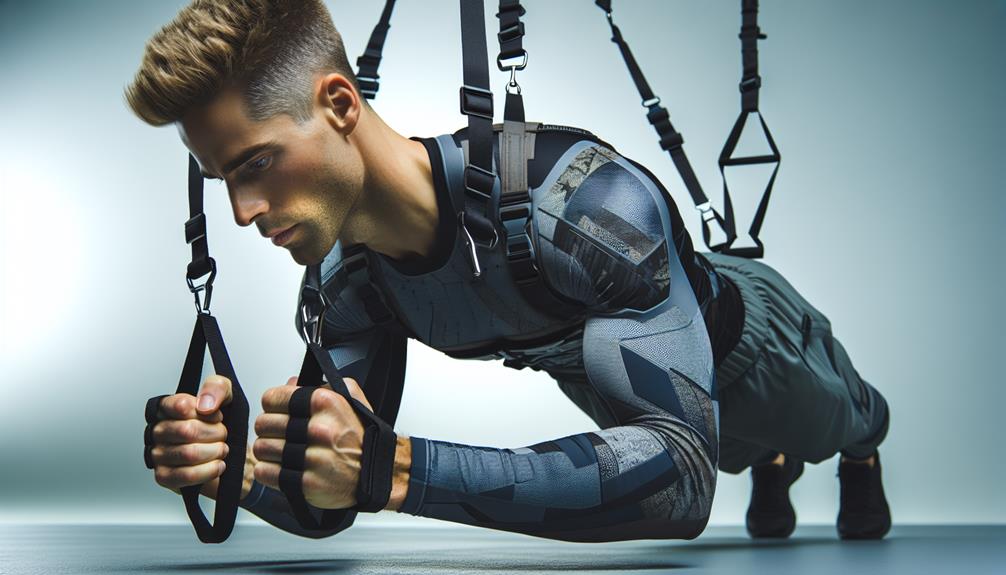Get ready to boost your fitness with our comprehensive suspension training plans. Engage multiple muscle groups, improve stability, and reduce injuries with strap workouts. Choose durable, adjustable straps with padded handles for maximum comfort. Set up by securing straps at the right height for varied exercises. Strengthen your core with plank variations and leg raises. Target arms, shoulders, and back with specific exercises for upper body strength. Strengthen legs, glutes, and core with lower body exercises. Try full-body routines for a challenging workout. Progress gradually, prioritize form, and stay consistent. Elevate your training game with advanced strategies. Recover well for optimal performance. Let's maximize your workout potential!
Benefits of Suspension Training
Suspension training offers a dynamic workout experience that engages multiple muscle groups simultaneously, enhancing strength, stability, and flexibility. When we incorporate suspension training into our fitness routine, we aren't only challenging our muscles but also improving our overall stability and flexibility. The instability of the straps forces us to engage our core muscles constantly, leading to improved stability throughout our bodies. This enhanced stability not only helps us during workouts but also in our daily activities, reducing the risk of injuries.
Moreover, the versatility of suspension training allows us to target different muscle groups while also working on our flexibility. By adjusting the straps and body positioning, we can perform a wide range of exercises that promote increased flexibility. This flexibility is crucial for maintaining a full range of motion in our joints, preventing stiffness, and aiding in better posture. Embrace suspension training to experience the benefits of improved stability and increased flexibility in every workout session.
Choosing the Right Straps
To ensure an effective suspension training experience, selecting the appropriate straps is crucial for maximizing your workout potential. When choosing the right straps, consider the following factors:
- Strap Material Options: Look for durable materials like nylon or polyester that can withstand your body weight and provide stability during exercises.
- Suspension Anchor Points: Ensure the straps you choose are compatible with various anchor points such as door frames, ceiling hooks, or outdoor bars to allow for versatile workout locations.
- Length and Adjustability: Opt for straps that are adjustable in length to accommodate different exercises and users of varying heights.
- Comfort and Grip: Choose straps that have padded handles or foot cradles for added comfort during workouts and a secure grip to prevent slipping.
Setting Up Your Suspension System

When setting up your suspension system, the first step is to identify a sturdy anchor point that can safely support your body weight during workouts. Proper anchoring is crucial for a secure and effective workout session. Look for doorways, exposed beams, or sturdy hooks that can bear your weight without any risk of giving way.
Once you have found a suitable anchor, adjust the height of your suspension straps to ensure they hang at an appropriate level for the exercises you plan to perform. Adjusting height is essential for targeting different muscle groups and accommodating various exercise movements. Make sure the straps are evenly adjusted to prevent any imbalances during your workout.
Core Strengthening Exercises
For a strong and stable core, engaging in a variety of challenging exercises is essential to build strength and endurance effectively. When using suspension training straps, core strengthening exercises can offer stability challenges and flexibility integration that traditional workouts may not provide.
Here are some key exercises to target your core muscles effectively:
- Plank Variations: Utilize the suspension straps to perform plank variations like side planks or plank pikes, engaging your entire core while also working on balance and stability.
- Leg Raises: Hang the straps low to the ground, grip them with your hands, and lift your legs, engaging your lower abs and hip flexors for a challenging core workout.
- Russian Twists: Sit on the ground, holding the handles of the suspension straps, and twist your torso from side to side, engaging your obliques and improving rotational stability.
- Mountain Climbers: Get into a plank position with your feet in the straps and perform mountain climbers, targeting your core, shoulders, and improving overall stability and coordination.
Integrate these exercises into your routine to strengthen your core effectively and maximize your overall fitness.
Upper Body Workouts
Engage your upper body muscles effectively with a diverse range of suspension training exercises that target your arms, shoulders, and back for a well-rounded workout experience. To enhance shoulder stability, try incorporating exercises like shoulder presses, lateral raises, and Y-raises into your routine. These movements not only strengthen your shoulder muscles but also improve their stability, reducing the risk of injuries.
For building arm strength, exercises such as tricep extensions, bicep curls, and tricep dips are excellent choices. By adjusting the angle and length of the suspension straps, you can increase or decrease the resistance to match your fitness level, making these exercises adaptable and challenging.
Remember to maintain proper form throughout each exercise to maximize results and prevent strain. Focus on engaging your core muscles to support your upper body movements and avoid excessive swinging. With consistency and dedication, you can achieve significant gains in both shoulder stability and arm strength through suspension training.
Lower Body Exercises
To target and strengthen your lower body muscles effectively, incorporate a variety of suspension training exercises that focus on your legs, glutes, and core for a comprehensive workout experience. When it comes to lower body exercises, the suspension trainer can be a game-changer, offering a challenging and dynamic way to engage multiple muscle groups simultaneously. Here are some key exercises to amp up your lower body workout routine:
- Glute Activation: Perform exercises like single-leg squats or hip bridges to activate and strengthen your glutes, enhancing your overall lower body strength and stability.
- Hamstring Curls: Engage your hamstrings by doing suspension trainer hamstring curls, a fantastic exercise to target the back of your thighs and improve leg strength.
- Quad Burners: Challenge your quads with exercises such as split squats or lunges using the suspension trainer, adding intensity to your leg workout.
- Calf Raises: Strengthen your calf muscles by incorporating calf raises into your routine, helping to improve lower leg strength and stability.
Full-Body Suspension Routines

Enhance your overall fitness and strength with dynamic full-body suspension routines that engage multiple muscle groups simultaneously, providing a challenging and effective workout experience. By incorporating stability challenges and functional movements, you can take your training to the next level and achieve a well-rounded fitness regimen.
Here is a sample full-body suspension routine that you can try:
| Exercise | Description |
|---|---|
| Suspended Push-Ups | Engages chest, shoulders, and triceps while challenging core stability. |
| Bodyweight Rows | Targets the back muscles and biceps, improving pulling strength and posture. |
| Suspended Pike | Works the core muscles intensely, enhancing overall stability and strength. |
| Suspended Lunges | Focuses on legs and glutes, promoting balance and coordination. |
| Plank with Leg Curl | Engages core, hamstrings, and glutes, enhancing stability and lower body strength. |
Integrate these exercises into your routine for a comprehensive full-body workout that will boost your strength, stability, and overall fitness levels.
Progression Tips for Beginners
For beginners looking to progress in their suspension training journey, focusing on mastering the foundational exercises with proper form and control is crucial. As you embark on this exciting fitness path, remember that consistency and patience are key to achieving your goals.
Here are some tips to help you advance safely and effectively:
- Focus on Technique Improvement: Pay close attention to your form during each exercise to maximize the effectiveness of your workout and reduce the risk of injury.
- Gradually Increase Intensity: Start with simpler movements and gradually challenge yourself by adjusting the angle or adding more resistance.
- Listen to Your Body: Rest when needed and don't push through pain. It's essential to strike a balance between pushing yourself and knowing your limits.
- Prioritize Injury Prevention: Warm up properly, stretch after your workouts, and ensure you're using the equipment correctly to prevent any unnecessary injuries.
Advanced Training Strategies

As we advance in suspension training, exploring innovative techniques to challenge our bodies and push our limits becomes an exciting next step in our fitness journey. To take our workouts to the next level, incorporating advanced techniques is key. One effective strategy is to increase the intensity by performing exercises on one leg or with added resistance. This not only engages more muscles but also improves balance and stability.
Another advanced technique is to incorporate plyometric movements into your routine, such as jump squats or explosive push-ups, to enhance power and agility.
Furthermore, integrating isometric holds into your exercises can provide intense challenges by forcing your muscles to work harder and develop greater endurance. For example, holding a static position halfway through a movement can significantly intensify the exercise. Remember, as we progress, it's crucial to maintain proper form to prevent injuries and maximize effectiveness.
Recovery and Maintenance Practices
To optimize our performance and ensure longevity in our fitness journey, prioritizing effective recovery and maintenance practices is essential. Taking care of our bodies post-workout is just as crucial as the workout itself. Here are some key recovery techniques and injury prevention strategies to incorporate into your routine:
- Foam Rolling: Spend time rolling out tight muscles to increase blood flow and flexibility, aiding in muscle recovery.
- Active Rest Days: Engage in light activities like yoga or walking to keep your body moving without putting stress on it.
- Proper Nutrition: Fuel your body with the right nutrients to support muscle repair and growth.
- Hydration: Stay hydrated to help flush out toxins and keep your muscles functioning optimally.
Frequently Asked Questions
Can Suspension Training Help Improve Flexibility and Mobility?
Absolutely! Suspension training can greatly enhance flexibility gains and mobility improvements. It helps prevent injuries, enhances performance, and boosts overall strength. By incorporating these exercises into our routine, we can achieve greater flexibility and mobility.
Are There Specific Exercises to Target Specific Muscle Groups With Suspension Training?
Absolutely, we've discovered muscle activation key in suspension training. Targeted exercises like chest presses and rows sculpt specific areas. To advance, try single-arm variations for more intensity. Progression is the name of the game!
How Can Suspension Training Benefit Individuals With Joint Issues or Injuries?
For individuals with joint issues or injuries, suspension training offers modified movements and rehabilitation exercises. Its low-impact nature helps in building strength gradually. Embrace this method to improve mobility, stability, and overall fitness.
Is It Safe to Perform Suspension Training at Home Without the Guidance of a Professional Trainer?
Performing suspension training at home without professional guidance can be risky. Safety precautions are crucial. Prioritize proper form, secure anchoring, and gradual progression. Seek online resources for guidance, but always prioritize safety in home workouts.
Can Suspension Training Be Integrated Into Other Fitness Routines Such as Weightlifting or Cardio Workouts?
Absolutely! We've found that integrating suspension training into our weightlifting and cardio routines has been a game-changer. The cross-training benefits are immense, offering versatility and enhancing overall strength, stability, and endurance.
Conclusion
So, get ready to take your training to the next level with suspension straps!
With the right setup, exercises, and progression tips, you'll be mastering workouts like a pro in no time.
Remember, consistency is key, and with a little dedication and hard work, you'll be amazed at the progress you can make.
So strap in, push yourself to new limits, and watch your strength and fitness soar to new heights!
You've got this!













